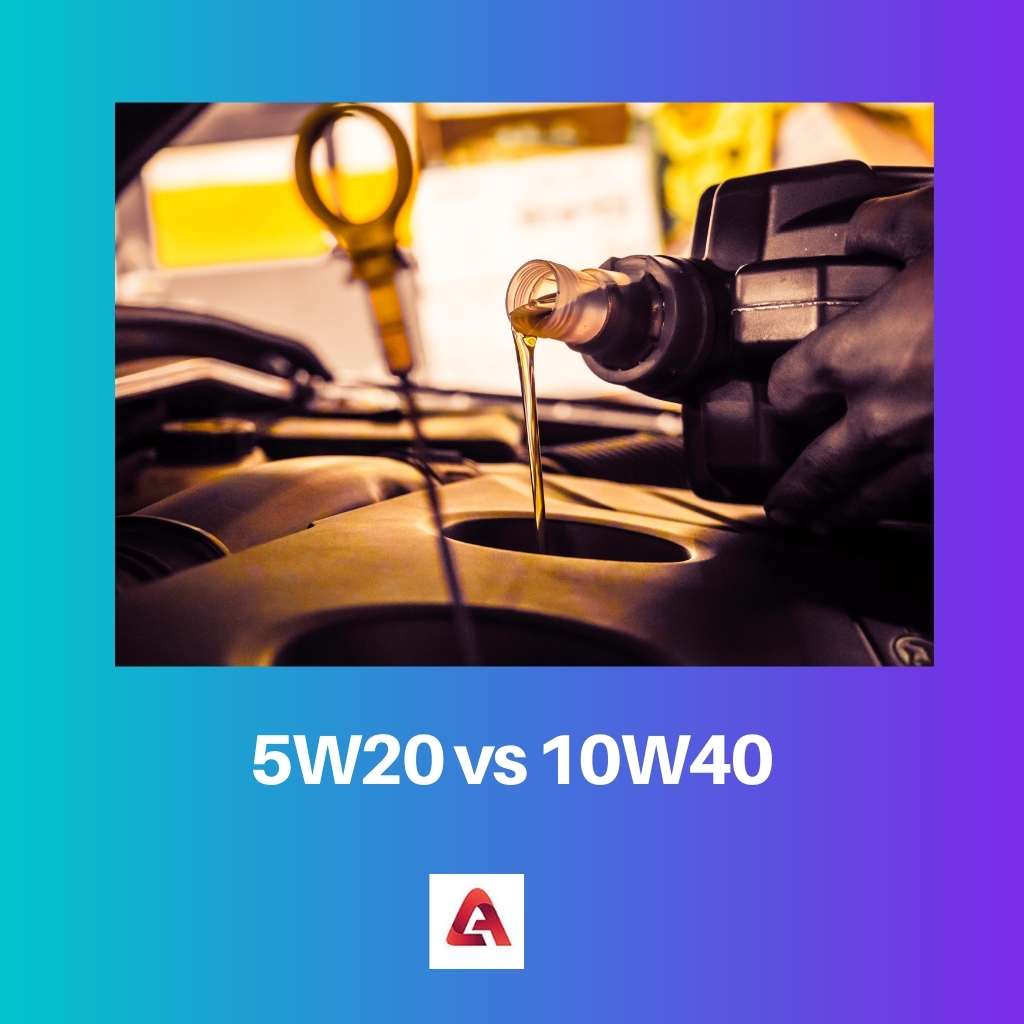The circumstances in a cold environment are very different from other regions. The way of living every day by those people is completely different.
So goes to the oils used in their vehicle where oils in a car engine are different of people who do not belong to a colder region. 5W-20 and 10W-40 are two types of motor oils suitable for driving vehicles in colder regions.
Key Takeaways
- 5W20 oil is thinner and flows more easily at low temperatures than 10W40 oil.
- 10W40 oil provides better protection at high temperatures than 5W20 oil.
- 5W20 oil can improve fuel efficiency, while 10W40 oil offers greater engine wear protection.
5W20 vs 10W40
The difference between 5W-20 and 10W-40 is that 5W-20 works best in winter while 10W-40 is an oil that is considered to be great for vehicles in hot reigns especially in the summer season. Both 5W-20 and 10W-40 are very beneficial motor oil and also advantageous in fuel economy. Their uses have been increased by the passage of time.

5W-20 refers to oil which is particularly a winter viscosity grade oil. This oil is used in vehicles for the better lubrication and performance of engines during winters.
The number used after W is to signify the level of viscosity of the oil at a certain temperature. 5W-20 oils are very beneficial in a snowy region.
According to the SAE (Society of Automotive Engineers), the term 10W-40 is considered to be the weight or viscosity of the motor oil.
10W-40 oils can be replaced with 10W30 depending on the need. The viscosity amount of 10W30 oils is known to be 40 when the temperature is high and 10W when the temperature is low.
Comparison Table
| Parameters Of Comparison | 5W20 | 10W40 |
|---|---|---|
| Thickness | The main feature of 5W-20 oil is that it gets thinner if it is in a low-temperature zone. | The main feature of 10W-40 oil is that it gets thicker in a low-temperature zone. |
| Range of temperature | The range of temperature adapted by 5W-20 oil is – 30⁰C to 35⁰C. | The range of temperature adapted by 10W-40 oil is – 18⁰C to 30⁰C. |
| Thinness | A major feature of 5W-20 oil is that it gets thicker if it is at a high temperature. | A major feature of 10W-40 oil is that it gets thinner at a high temperature. |
| Grade of viscosity | Talking about the viscosity of 5W-20 oil, it is considered to be lower than other motor oils. | Talking about the viscosity of 10W-40 oil, it is considered to be higher compared to 5W-20. |
| Usage | 5W-20 motor oils are commonly used for that engines that are powered by petrol and diesel or used for light duty. | 10W-40 motor oils are commonly used for hauling engines that are mostly used for heavy load. |
What is 5W20?
5W-20 oils are widely known for their stunning start-up performance. These oils are commonly used in an environment with cold temperatures because 5W-20 oils offer excellent engine protection.
5W-20 oils are also known as multi-grade oil. Breaking down the meaning of its name, the first digit before W represents the viscosity of the oil at 0⁰ Fahrenheit.
In other words, the lower the digit is, the better the performance of the oil will be at low temperatures. Now talking about second digits after W, this digit shows the performance of the oil or viscosity at a high temperature.
This temperature can be up to 212° Fahrenheit. So by this explanation, one can understand that 5W-20 oil is a thin oil at high temperatures.
5W-20 oil is considered to be great for starting up an engine since it flows rapidly and reaches quickly Targeted areas. The thinner viscosity of 5W-20 oil is great for causing less friction and oil consumption.
This oil also decreases the need for lots of energy.
People who use the car for driving in a colder environment can rely on 5W-20 oil due to its low viscosity properties. The 5W-20 oil is made of crude oil and other additives.
Although, many users suggest that 5W-20 should only be used with the direction of a car mechanic or car manufacturer.

What is 10W40?
Motor oils have different types and for colder areas, different types of motor oils are available in the market. Ordinary motor oils get thicker in cold temperatures while in high temperatures, such oils get thinner and that could be a serious problem.
Ordinary motor oils can cause a lot of damage to the engine.
To solve this problem, people in cold regions use 10W-40 oils. The main characteristic 10W-40 oils contain is that such oils do not get obtain viscosity when they are heated up.
When the environment is hot, 10W-40 oils act like 40 weight, and in a cold environment, these oils perform like 10W weight oil.
The 10W-40 W stands for weight. 10W is for cold temperature viscosity while 40 is there to represent viscosity in high temperature.
10W weight oils are used in passenger cars of modern times, these oils are also used in light trucks’ heavy-duty engines.
Engines that are based on diesel can also use 10W-40 oils for the start-up. Also, some engines might have burning or leakage problems but it does not affect 10W-40 oils to do their job.
10W-40 oils flow much better than any conventional motor oil, also known as mineral oil.

Main Differences Between 5W20 and 10W40
- 5W-20 motor oils are considered to be most suitable for the engine in the winter season. On the other hand, 10W-40 motor oils are suggested to be used in the summer season.
- When it comes to lubrication, 5W-20 oil are the best option to choose, while 10W-40 oils come with moderate lubrication.
- 5W-20 is known to be the best suitable oil for a vehicle that is private. On the other hand, 10W-40 oils are suggested for commercial vehicles.
- 5W-20 oil is known to be best for a vehicle that has traveled more than 1000,000 km. While 10W-40 is quite useful when the vehicle is new.
- 5W-20 oils get thinner at low temperatures that are found in winter season, while 10W-40 tend to be thinner at high temperatures.

I’m not convinced that the differences between these oils are as significant as the article makes it out to be. There’s probably more to it than this, and I think the article oversimplifies the topic.
Great article. It’s very informative and everyone living in a cold region should know about the differences between these two types of motor oils. This is essential knowledge for anyone who relies on a vehicle year-round. I’m glad I read it. Thank you.
Yes, I agree. This was an enlightening article. I learned a lot about motor oils that I didn’t know before.
I always wondered about the differences between 5W-20 and 10W-40 oils. This article does a great job of explaining the distinctions and benefits of each. Very useful information.
I’m not convinced that the information in this article is entirely accurate. It seems to simplify a complex issue and might not provide a complete understanding of the distinctions between these motor oils.
This article is very informative. It does a good job of explaining the differences between 5W-20 and 10W-40 oils. It’s clear that the choice between these oils can have a significant impact on a vehicle’s performance.
The article presented a good comparison between 5W-20 and 10W-40 oils. I appreciated the detailed explanations and charts. This is a valuable resource for vehicle owners living in different temperature environments.
The article is spot-on when it comes to providing vital information for vehicle owners who experience cold temperatures. It’s a must-read for those who aren’t familiar with the importance of using the right type of motor oil in such conditions.